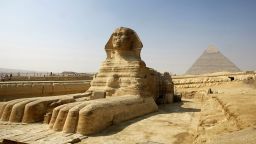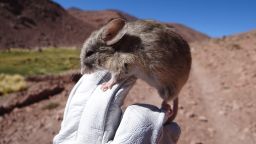To date, tens of millions of animal mummies have been unearthed in Egypt. But while there are millions of mummified cats, dogs, ibises and birds of prey, primate mummies are rare — and little understood.
Now, new analysis of mummified baboons is shedding light on the animals’ place in ancient Egypt, revealing that, while they were prized as sacred animals, their living conditions were less than ideal.
Researchers analyzed bones from mummified baboons, which were discovered in the early 1900s in the necropolis Gabbanat el-Qurud, in the so-called Valley of the Monkeys, to the southwest of Egypt’s Valley of the Kings. The bones represented dozens of individual baboons — from infants to adults — in two species: the hamadryas baboon (Papio hamadryas) and the olive baboon (Papio anubis).
These species weren’t native to Egypt — they were imported from two regions: “the olive baboon from the south (present-day Sudan), and the hamadryas baboon from mountainous areas bordering the Red Sea, in Sudan and southwards to Eritrea, Somalia and Ethiopia,” said lead study author Wim Van Neer, a professor emeritus at the Royal Belgian Institute of Natural Sciences in Brussels. “The exact provenances still need to be documented in more detail,” Van Neer told CNN in an email.
Of all the animals that the ancient Egyptians venerated, baboons were the only ones not native to Egypt, Van Neer added.
The baboons are thought to have played a role in ancient Egyptian rituals, the scientists reported Wednesday in the journal PLOS One. But raising and caring for large wild animals — particularly non-native species — is challenging. Before their deaths the baboons were sunlight-deprived and developed bone ailments from poor nutrition, researchers discovered. Examination of the skeletal remains revealed signs of rickets; the baboons had deformed arms, legs and faces, undeveloped teeth, osteoarthritis and other pathologies due to deprivation and metabolic disease.
Their deformities resembled those seen in the bones of baboons from two other ancient Egyptian sites — Saqqara and Tuna el-Gebel — dating to around the same period, the authors wrote.
“This excellently crafted and executed study confirms the results of some earlier investigations concerning the health status of baboons in ancient Egypt,” said Dr. Salima Ikram, a Distinguished University Professor of Egyptology from the American University of Cairo, who was not involved in the research. “More importantly, it also establishes the fact that different types of baboons were being brought to and reared in Egypt,” Ikram told CNN in an email. “It is fascinating to think that the ancient Egyptians tried to institute a breeding programme for baboons so that they could both be revered as well as used in religious rituals.”
A jumble of bones
At the three main Egyptian sites where mummies of Old World monkeys were interred, 463 mummified primates have been discovered, according to the study. The baboon bones examined for the new analysis were collected in 1905 and 1906 by archaeologists from the Muséum d’Histoire Naturelle de Lyon in France (now the Musée des Confluences).
In the tombs were pieces of dried skin with long tufts of hair still attached, suggesting that the animals had been placed there as mummies. The French archaeologists recovered 23 skulls, 24 mandibles and more than 200 isolated bones, which were assembled into complete skeletons regardless of whether all the bones belonged to the same baboon, according to the study.
Two skeletons had been cobbled together from bones belonging to two different baboons, and one skeleton represented three of the primates. Of the four skeletons that were properly put together, only one had the correct skull. After analyzing the bones one by one, the study authors identified 36 different baboons of all ages, a set with more adults than juveniles and a few more males than females.
The bones also revealed signs of metabolic problems during adolescent growth, including curved shafts, misshapen shaft heads and arthritic joints. Two female baboons had suffered from tooth decay. There were lesions in some of the skulls; two of the primates had shortened snouts, and two others had snouts that bent to the left.
The mummies were also centuries older than previously thought. Based on the mummies’ proximity to nearby ceramic artifacts in the tombs, earlier estimates placed them between the first and second centuries at the earliest, and possibly as recent as the seventh century.
But when the study authors examined bone collagen and fibers from a textile that had been wrapped around an intact baboon mummy, they found that the animals were likely entombed between 803 and 520 BC. The researchers confirmed that time frame using a technique called radiocarbon dating, which can determine the age of organic material by measuring the amount of decay in a radioactive isotope of carbon.

Sacred and suffering
Conditions for the captive primates may have been even worse than their remains suggested, as bones often don’t preserve records of parasites and other types of ailments, the researchers reported.
However, it’s important to note the scientists’ findings don’t suggest that the baboons were being intentionally abused. Their keepers likely did the best that they could to care for the animals, “but this must not have been easy,” Van Neer said.
“Baboons are good climbers and they were therefore probably kept in buildings or enclosures with high walls to prevent them from escaping. Because of the lack of sunlight they developed the metabolic disorders that we see, mainly rickets. There are no signs of broken bones that would suggest the animals were ill-treated physically,” he said.
“Unfortunately, the Egyptians did not know enough about the care and feeding of baboons,” Ikram added. “While trying to give them reverence and care they actually established conditions detrimental to the health and well-being of the animals — the way to hell is paved with good intentions!”
Mindy Weisberger is a science writer and media producer whose work has appeared in Live Science, Scientific American and How It Works magazine.







